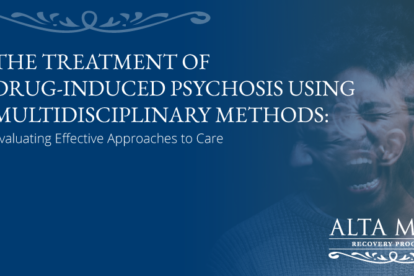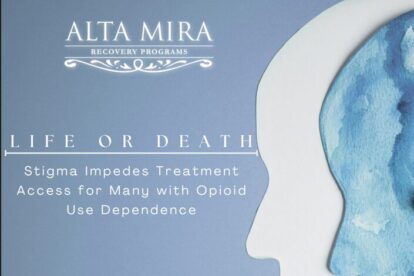Alcohol Dependence and PTSD
We invite you to watch “Alcohol Dependence and PTSD,” a presentation given by Steven L. Batki, M.D. at Alta Mira Recovery Programs. A summary of the presentation is available below.
Steven L. Batki, M.D. from Alta Mira Recovery Programs on Vimeo.
Treatment programs are seeing a marked increase in clients who suffer from co-occurring PTSD and Substance Use Disorder (SUD), in particular Alcohol Dependence. Clients with both PTSD and SUD can be difficult to manage because of the complexity of the interactions between the two disorders, which share common neurological underpinnings. Fortunately there are approaches and disciplines for handling patients with complex trauma and SUD that can significantly improve client outcomes.
Steven L. Batki, M.D., Medical Director at Alta Mira Alta Mira Recovery Programs, specializes in treating patients with SUD and PTSD. In a recent lecture, he addressed some of the most prevalent challenges in diagnosis and treatment, as well as the current research surrounding effective treatments for patients suffering from this complicated co-morbidity. What follows is a summary of his presentation. We invite you to watch Dr Batki’s full lecture available here: Alcohol Dependence and PTSD.
Dr. Batki notes a number of treatment challenges for clients suffering from PTSD and SUD:
• Clients have difficulty managing symptoms and regulating behavior
• Co-occurrence worsens outcomes for each individual disorder
• Both disorders increase impulsivity and neurocognitive impairment
• Both disorders share neurobiological mechanisms that cause disordered arousal symptoms
• Little research exists to guide medication management
Recent studies from the San Francisco VA show that patients with a PTSD diagnosis have a 3-4 times higher rate of substance disorders than the general veteran population, which is similar to rates of co-occurrence in the general population. PTSD symptoms have generally been thought to drive the SUD, with patients “self-medicating” through substance use. However, there is also evidence of bi-directionality, with substance use as a clear risk factor for developing PTSD or intensifying symptoms. It is clear that treating PTSD can positively impact SUD; it is not yet clear if treating substance use as the primary disorder will also reduce the intensity of PTSD symptoms.
Begin Your Recovery Journey Today
866-922-1350Effective Treatments
A number of recent studies have looked at both trauma-focused therapies (desensitization through exposure) and non-trauma focused therapies (various forms of CBT). The research clearly indicates that treatment can be effective in reducing both disorders. However, most of the research has been done without a control group, making it difficult to draw firm conclusions about which treatment type is best. The good news is that clients are clearly improving from therapeutic interventions for both disorders. The challenge lies in predicting which interventions are most likely to be effective for individual clients. Dr. Batki reviews a methodology called “Seeking Safety” that has been shown to successfully treat both disorders simultaneously.
While substantial research exists showing marked benefits of medication management in treating substance use and preventing relapse, there is more limited success in medical treatment of PTSD symptoms. Doctors have found medication strategies for treating symptoms such as psychological distress, hyper-arousal, and avoidance, but with little ability to predict what will be effective for each individual. The situation is even more complex for treating clients whose PTSD is accompanied by SUD. Few studies have been done on medication use to treat this co-occurrence; those that have been done have not shown a marked benefit from medication use.
In conclusion:
• Psychotherapy is the primary path of treatment for co-occurring PTSD and SUD
• There is evidence of successful pharmacotherapies for each individual disorder, but little research about what works for co-morbidity
• Treating the symptoms that both disorders have in common is particularly important, including impulsivity, risky decision making, and hyper-arousal






